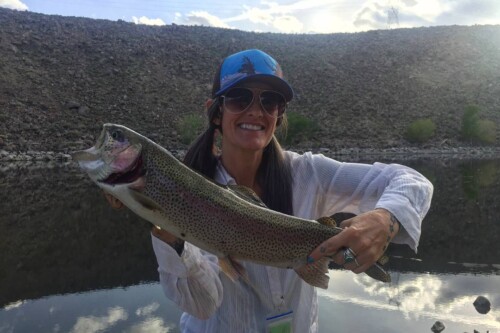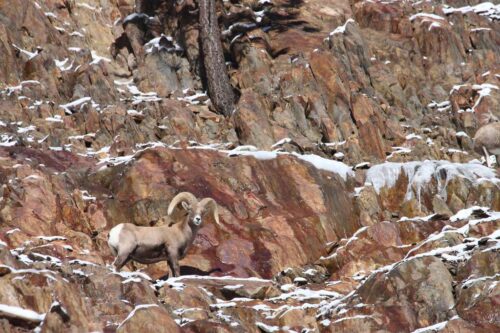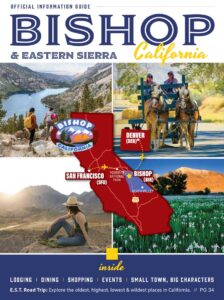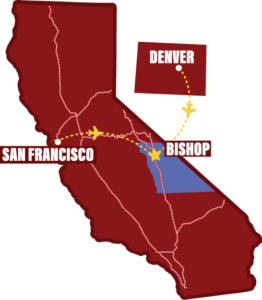White Pelican Migration in the Eastern Sierra
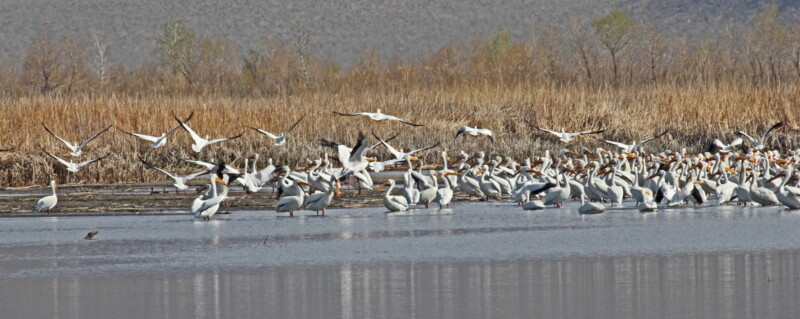
Many locations have spectacular wildlife observation opportunities and the Eastern Sierra can claim one of them. If one wants an awe inspiring experience with Sandhill Cranes, a winter trip to Bosque del Apache National Wildlife Refuge, New Mexico, will not disappoint. If your taste runs to whales, a pelagic trip in fall or spring out of Monterey, CA will produce several species, many up close and personal. Some exciting wildlife observations involve one mammal, a Mountain Lion or Marten, or one fish, “it was THIS long!”, or one bird, a Golden Eagle stooping on a Sage Grouse. But the Eastern Sierra’s biannual event, in March and April and again August to October, involves thousands of very large and very graceful birds…the American White Pelican.
In early April 1998, we were driving south on Hwy 395 towards Big Pine when we noticed oncoming traffic pulling off the highway, en masse, onto the shoulder. We assumed an emergency as people were exploding from their vehicles but then realized that they were pointing into the sky and some were grabbing cameras to take pictures. Quickly we pulled off to see what could make a dozen car owners decide to do the same thing simultaneously. As we looked into the clear blue sky we had a second or two where we saw nothing and then, magically, an apparition of silvery-white dots formed and sharpened to show thousands of white birds with large yellow bills and black wing tips…pelicans. The crowd could be heard claiming that they’d never seen such a beautiful ballet…ohhhhh….so many birds at once…such grace and timing…ahhhhh…how did they not bump into each other…amazing! Too soon the flock of over five thousand birds continued moving to the north to their breeding grounds and disappeared. There was no way to know if these birds would breed as close to us as northeast California or northwest Nevada or were going to continued further north into western Canada.
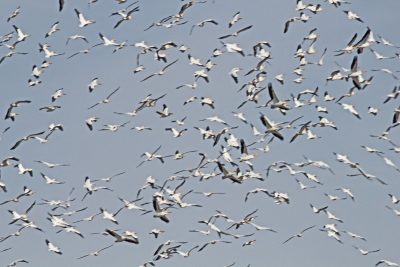
The American White Pelican
is among the largest flying birds with a wingspan of 8-9 feet and weighing in at 11-20 pounds or more, with males slightly larger than females. They winter in the southwestern U.S., Gulf States, and Mexico. In March 1987, 40,000 pelicans were recorded at the Salton Sea and Patten, McCaskie, and Unitt (2003:82) estimate that one-third to one-half of the entire population of American White Pelicans spend the winter there with most of the balance of birds in western Mexico and the Gulf Coast of the southeastern U.S.
The Eastern Sierra is a reliable region to view these graceful giants in migration. The many reservoirs and lakes provide resting and eating zones and the mountains provide the thermals necessary for these large birds to get airborne. They are diurnal migrants and often can be seen in the early morning at Tinemaha Reservoir and Crowley Lake. If undisturbed they linger in the morning as they wait for the sun and mountains to work their thermal magic. They exercise their wings, first a few birds, then more, and then almost the whole flock at once. Then one bird is airborne, quickly followed by a small group, then many small groups, and then the entire flock. The sound of thousands of wings straining to lift their heavy bodies is not something one will ever forget.
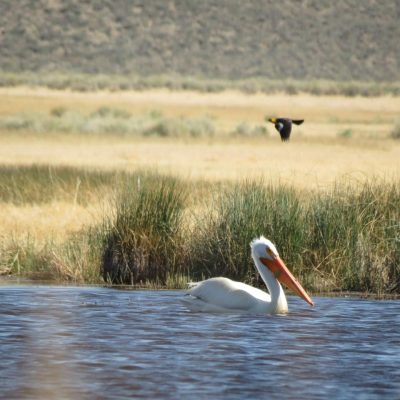
At Tinemaha Reservoir in spring, they move towards the north end until between 0830-0930 when their muscles are warmed and stretched and the thermals are beginning their elevator ride up the mountains. Once the groups become airborne, there is a period when the sky seems filled with chaotic patterns of whirling and swirling subgroups flying directly at other subgroups and then becoming a part of another group. As they soar the thermals generate lift and seemingly without any effort the pelicans begin to gain altitude, the groups coalesce into organized units, V’s are formed of 40-80 birds, each riding the bow wave of the one in front of it. After a time, the leader of the V allows another to become the bow to plow through the air creating a smoother path for those that follow and the former leader will choose a spot further back in line to take a well-earned rest, yet maintain his position within his group seemingly without effort. In a surprisingly short time, the uplifting and inspiring performance is over as the birds reach altitude and aim their internal compasses north leaving the observers awe-struck and wishing it has lasted longer…but the pelicans have miles to go before they sleep.
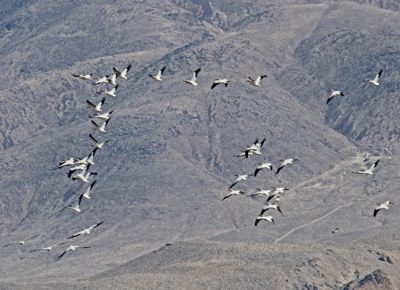
With no headwind to hinder progress or tailwind to assist, the average speed a pelican flies is about 35mph. Late afternoon will find the flocks from Tinemaha Reservoir north of Reno, NV. If their breeding home is Anaho Island at Pyramid Lake, their trip is almost completed. If they are inbound to breeding grounds in British Columbia or Alberta, another couple of days may be required.
Both sexes fly together in these flock although pair formation does not take place until they reach their breeding grounds. Two eggs are laid, although the first to hatch is frequently the only one to survive and incubation lasts about 30 days. American White Pelicans do not breed until they are three years old. In their first year, 41% will not survive and in their second year 16% will perish.
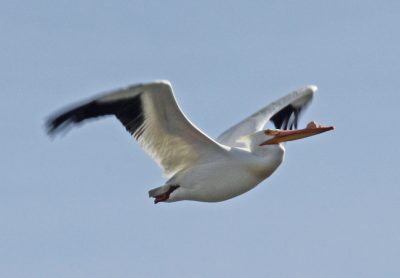
American White Pelicans are often reported in the Eastern Sierra during the summer. These are probably failed breeders or sub-adult birds that are not old enough to breed. As time, our worst enemy, flies by, it will not be long before we see the first Vs returning from the north and in the late afternoon the birds begin breaking out of formation over reservoirs or lakes to settle down for the night. In the morning they begin the ritual to get their bodies and wings ready for another day of flying. Before we know it they are gone, taking with them a magnificent avian performance, and leaving behind memories and stories of what once was.
Guest post by Tom and Jo Heindel, Eastern Sierra Audubon Society Find more articles like this here.
All photos by Tom & Jo Heindel, and Aaron Johnson.
Written by:
Vickie Taton
Since taking a chance summer job in 1980, I've lived in and loved the eastern Sierra. Sometimes home is a place you've never been before, and that is how I felt driving north into Inyo and Mono Counties so many years ago. It really doesn't matter the activity; fishing, hiking, skiing, riding my horse or mountain biking, I love the clean air, the cobalt blue sky, the constantly changing weather. Welcome! I'm happy to share a little piece of this place with you.

